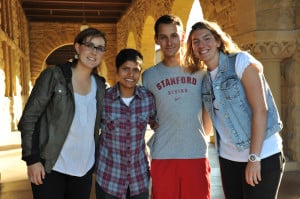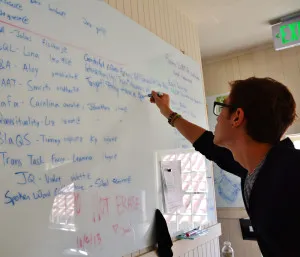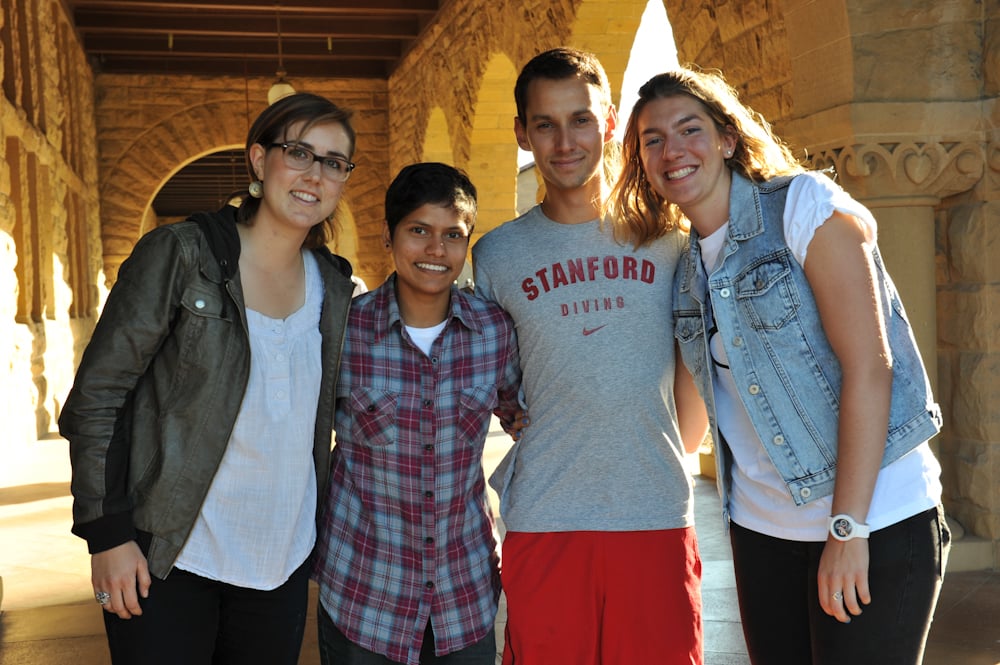It has been an exciting fall for Cardinal sports, with the football team’s demolition of Washington State, the women’s soccer team’s thrilling come-from-behind victory over Santa Clara and the field hockey team’s 366-minute shutout streak. But there has also been another exciting change in Stanford stadiums: the presentation of the “If You Can Play, You Can Play” video, part of an ongoing effort to help make the Farm a safer place for LGBTQ athletes.
The video — which will play at every Cardinal sports venue this year — was produced last spring by the Stanford Department of Athletics and Stanford Athletes and Allies Together (StAAT), a student group dedicated to supporting LGBTQ and allied athletes.

Building a foundation
In May 2012, Stanford was placed on the list of the top 10 most LGBT-friendly colleges for athletes by Campus Pride, a non-profit supporting LGBT and allied students on college campuses. Yet many athletes on the Farm felt that the recognition was unwarranted.
“We didn’t feel like we actually deserved it,” said Toni Kokenis ’14, one of the four founders of StAAT. “We felt like we only got the award because Stanford itself is very LGBTQ-friendly, and we are also one of the best athletic departments. It felt like they kind of just put the two together.”
After the announcement, a group of Stanford alumni, students and staff members hosted an event to both celebrate the award and to start spreading awareness about the topic.
“We felt that we were pretty far behind and we kind of used the event to spark awareness,” Kokenis said. “We wanted to show that we got this award, and that we should actually start doing things to back this up.”
Following the momentum of the event, Kokenis reached out to Cardinal diver Noah Garcia ’14 about creating a group focused on developing a safe community for LGBTQ athletes.
“This was something that I had been thinking about for a while, because there wasn’t really any group on campus that was representative of who we were,” Garcia said. “I was sort of afraid to go out of my way to start thinking about it or start making anything happen. Having Toni’s initiative really inspired me.”
As StAAT was born, Garcia and Kokenis were joined by women’s club soccer player Annie Graham’14 and women’s rugby player Smriti Sridhar ’15. Kokenis also credited the work of older members in the Stanford community such as Holly Fetter ’13, Xanthe Travlos ’11 and Laura Wadden ’09, for laying the foundation for the organization.
“We are in a unique situation of having these cultures of really good athletics and a really strong queer community,” Graham said. “I definitely think it’s important that we step up. Because we have so many talented athletic teams, we should definitely focus on making those teams wonderful groups of open people as well.”
Struggles faced
LGBTQ athletes can often face challenges unique to the locker room and team environment.
“There are certain stereotypes that come along with being an athlete and certain stereotypes that go along with homosexuality, and I don’t think the two overlap a lot,” said Stanford gymnast Cale Robinson ’14. “So I think people are often kind of taken aback and shocked when there are gay athletes.”
These athletes specifically emphasized the prevalence of gender stereotypes within their sports.
“Something we have come across a lot [at StAAT] is that there is definitely a need to represent some sort of image of masculinity or femininity depending on your gender,” Garcia said. “That plays a big role in feeling comfortable about revealing some sort of sexual orientation and how that might be associated with being weak.”
Kokenis said female athletes in more masculine sports are often affected by the stereotype that all really good female athletes must be lesbians.
“A lot of athletes feel that if you are LGBTQ, that you need to hide your sexuality so that you are not conforming to the stereotype,” Kokenis said. “Or if you are straight, you need to over-emphasize your femininity to make sure that you aren’t conforming to the stereotype.”
Robinson said that the sport men’s gymnastics has often faced a perception that it has a lot of gay athletes.
“I was around this culture up until the point that I came to Stanford, a culture that was hyper-sensitive about being looked at as a gay sport. There was always a big effort to do everything we could to not be seen as a gay sport,” Robinson said. “I was never comfortable coming out or anything like that in club or really in any other environment except for Stanford.”
The team environment can also make coming out more difficult. Robinson said there is a notion that if an athlete comes out as gay, then the whole culture of the locker room is going to change.
“It’s not really an issue that’s talked about, and that silence can be really scary for an athlete that is in the closet and not sure how their teammates and coaches are going to respond,” Kokenis said.

Creating safe spaces
StAAT’s main focus has been on creating safe spaces for all varsity and club teams while also working to make the athletic department more conscious of LGBTQ adversities.
Kokenis said that while Stanford had a very active and visible LGBTQ community, that activity didn’t necessarily translate to the LGBTQ athlete community.
“When we got the award, we realized that all of these resources do exist, but very few athletes were taking advantage of these resources,” Kokenis said. “We knew how accepting the overall community was, but you didn’t really get that feeling of acceptance in the locker room or in the overall athletic environment.”
StAAT kicked off their campaign last fall with a panel of LGBTQ athletes as part of the LGBTQ Community Resource Center’s “Safe and Open Spaces at Stanford” program.
The group then began hosting weekly meetings for athletes to share experiences and seek advice. Some of the discussion topics included goals for the organization, ways to help teammates become better allies and strategies for dealing with difficult situations.
In October, Hudson Taylor, a three-time NCAA All-American wrestler at Maryland and the founder of the non-profit Athlete Ally, came to campus to speak to the athletic community about the importance of athlete allies.
Lexie Ross ’13, a member of the women’s water polo team, said Taylor’s talk helped initiate a change in her team environment. After the speech, Ross said head coach John Tanner held a meeting with the team to make clear that any sort of judgment or discrimination would not be tolerated.
“It was the first time since I had been on the team that [Tanner] had ever actually acknowledged that there were people on our team that were not exactly the same as other people,” Ross said. “It was refreshing to know that he was on that page and that everyone on the team was on that same page.”
Collaboration with Department of Athletics
In addition to providing a safe space for athletes to talk to other athletes about these issues, StAAT wanted to make sure there was an organized effort to speak to the athletic department about this topic.
“The athletic department has so many things to focus on that we as the students need to be focused on consistently talking to them about what we want,” Graham said.
Both sides said the partnership has been successful so far. Senior Associate Athletic Director Earl Koberlein credited StAAT with being proactive, organized and passionate about creating change, while representatives of StAAT said that the athletic department was “willing to help [us] in any way possible.”
Kokenis, who attended the Nike LGBT “Go Athlete” sports summit this June, said that after meeting with LGBTQ student-athletes from around the country, she believed that Stanford has one of the most supportive athletic departments.
“Many athletic departments were hesitant to support LGBTQ initiatives because they didn’t want it to appear negatively to their own image, per se,” Kokenis said. “From what I have heard, we have the strongest alliance with our athletic department — we are actively trying to work with them and make sure that this is something we are doing together.”
StAAT and the Department of Athletics used their partnership to organize a panel of LGBTQ athletes and allies to speak at a coaches’ meeting in the spring.
Additionally, the group handed out rainbow flags and stickers that they encouraged coaches and staff to put on their doors or in their offices.
“StAAT impressed upon us how important a little thing like a flag or sticker is to a student,” Koberlein said. “We are trying to make that a priority so they know that we are a safe place and that there are a lot of safe places around the athletic department for students to come to.”
For Robinson, this small change made a big difference. Robinson said that before StAAT, many student-athletes didn’t know if they could approach their coaches about challenges related to their sexual identity.
“I know my coach now has a sticker in his office that says he is an ally and that this is an LGBT safe area,” Robinson said. “[Coaches] don’t necessarily have to support LGBT rights, but I think that every student-athlete has to know that they are in a safe place and I think that’s what the athletic department is doing right now.”
Graham sees the Department of Athletics’ commitment as an important sign of future leadership.
“If our meeting with the athletic department is any indicator — and I think that it is — then Stanford is definitely willing to be a leader on this and wants to be a leader on this,” said Graham.
You can play
The ‘You Can Play” video was also a joint effort between StAAT and the Department of Athletics. The video has either a coach or player from every team on campus to help share the message that “If you can play, you can play,” regardless of gender or sexual identity.
Koberlein said the video—which also includes representatives of athlete support services such as the weight room and the Athlete Resource Center (ARC) —is an important representation of Stanford’s supportive position.
“We’re throwing [the You Can Play video] out there; we are really making that a priority, to be accepting and that someone’s sexual orientation is not going to be a negative,” Koberlein said. “I think publicizing that is a step in that direction.”
What the future holds
While most athletes said their overall experience at Stanford has been positive, both the athletic department and StAAT expressed a desire to continue improving support networks and leading the charge for universities across the country.
“Spreading awareness about the issue and education will be our main goal,” said Kokenis. “We are trying to get more people involved by either just knowing that we exist as a resource or if they have a teammate that comes out to them—that we are a place where an athlete or ally can go.”
StAAT will continue having weekly meetings this year as well as the safe spaces panel. Additionally, StAAT hopes to build off of an idea spawned at UCLA and host an athlete-ally week filled with high profile speakers and events.
Another potential idea is a field day in the spring for athletes focused on the issue of inclusion. The idea would be to bring athletes together regardless of sexual orientation, race, religion or other dividing factors.
“From where we were a few years ago to where we ended this year, we have made huge strides,” Kokenis said. “A lot of that has to do with how supportive the athletics department has been. Obviously, we still have a lot of work to do but we are really optimistic and hopeful based on how last year ended.”
Contact Lucy Svoboda at lsvoboda ‘at’ stanford.edu.
